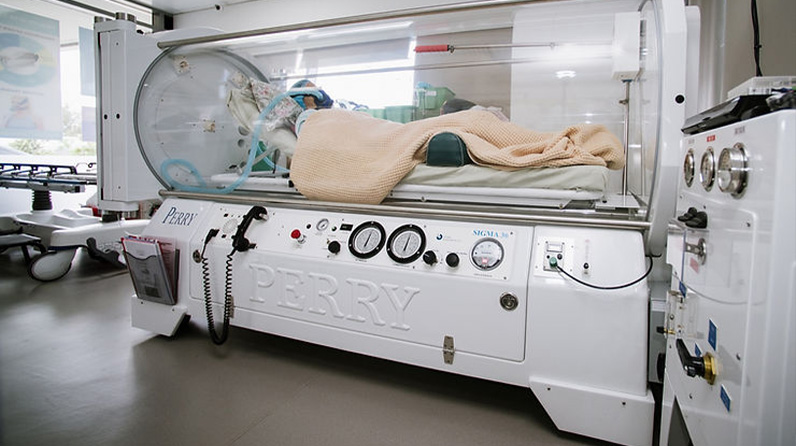How Does it Work ?
Under normal circumstances, oxygen is absorbed into circulation when we breathe and transported throughout the body only by red blood cells. Under pressure, oxygen can be dissolved into all of the body’s fluids, the plasma, the lymphatic system, the central nervous system fluids, and the bone. This allows us to dissolve, transport and deliver many more times the normal oxygen to our tissues and cells.

Why Does It Work ?
It has long been known that healing many areas of the body cannot take place without appropriate oxygen levels in the tissue. In many cases, such as circulatory problems and non-healing wounds, adequate oxygen cannot easily reach the damaged area.
Oxygen can be carried to areas where circulation is diminished or blocked. In this way, extra oxygen can reach the damaged tissues helping the body to support its own healing process. The increased oxygen enhances the ability of white blood cells to kill bacteria, reduces swelling and allows new blood vessels to grow more rapidly into the affected areas.
Hyperbaric Oxygen Therapy is safe and effective and provides this extra oxygen absorption with minimal side effects.

Different Types Of Chambers
Hard VS Soft Chambers…
Different illnesses require different treatment pressures. The “one size fits all” just isn’t so in a hyperbaric chamber because there is a distinct drug-dose response by the patient.
To fully benefit from the therapeutic effect of HBOT, pressure above 1.5 ATA is needed. Naturally and logically the cost of hard chambers is more expensive than soft chambers.
Different illnesses require different treatment pressures. The “one size fits all” just is not so in a hyperbaric chamber because there is a distinct drug-dose response by the patient. In a hospital HBOT chamber, gas gangrene is treated at 29 psig (3 ATA) of 100% oxygen. This provides the patient almost 16 times the partial pressure of oxygen of breathing room air at sea level. Diabetic ulcers respond to 19 psig (2.3 ATA) and heal quickly. Lyme disease and chronic fatigue syndrome patients need 2-2.3 ATA pressures to achieve a positive result. The inflatable chambers fail to deliver both the required treatment pressure and oxygen percentages for these health problems.The inflatable is pressurised to a mere 4 pounds per square inch (“psig.”) or 1.5 ATA ,by adding 4 psig air pressure, the oxygen density (partial pressure) jump from 21% to 27%. Most neurological and orthopaedic conditions including autism respond best to pressures between 1.7 to 2.0 ATA .
At Oxygen 4 Life, we only use Medical Grade Tier 2 Hard Chambers.

10 Primary Benefits Of Hbot
- Increased oxygen perfusion- (Immediate increase in free floating oxygen available for tissue use)
- Neovascularization- Angiogenesis (new blood vessel growth)
- Increased white blood cell function (improved neutrophil and macrophage activity)
- Nerve healing factors (increases in VegF, BDNF, HIF1)
- Wound healing Increased capacity for healing (PDGF, VegF, collagen production circulatory healing)
- Stem cell release (up to 8-fold increase in mesenchymal and CNS stem cells)
- Vasoconstriction (decrease edema and swelling from damaged tissues)
- Mitochondrial healing (increase in size, shape and number of mitochondria)
- Anti-inflammatory (reduction of inflammatory cytokines, increase in anti-inflammatory cytokines)
- Anti-microbial/microbiome balancing (reduction in anaerobic pathogens and increase in aerobic probiotics)
